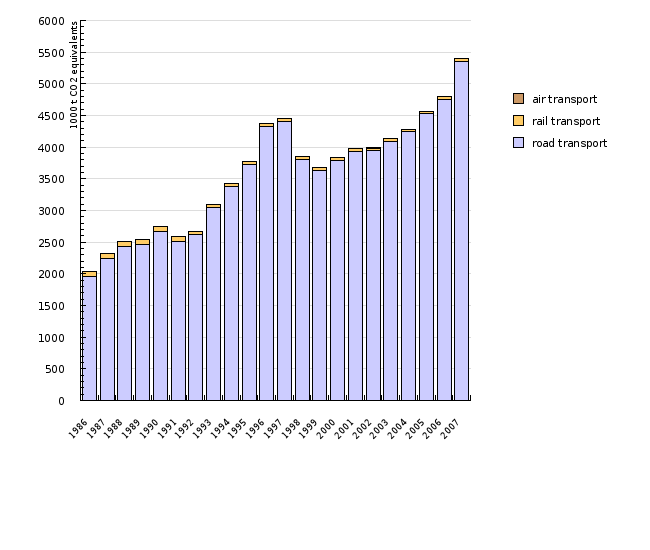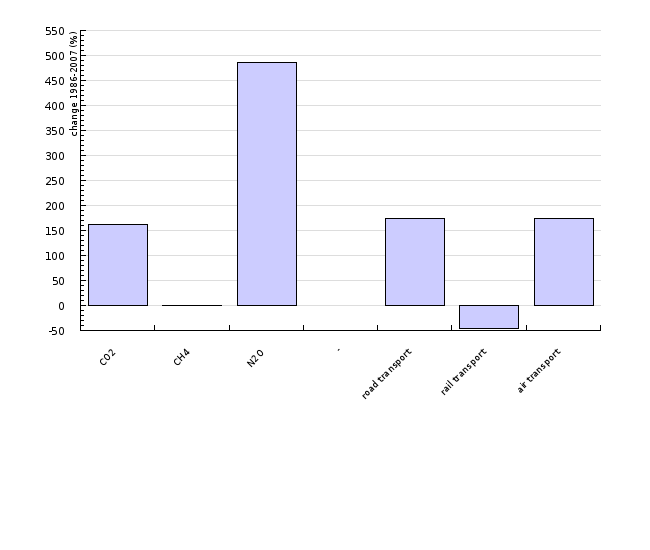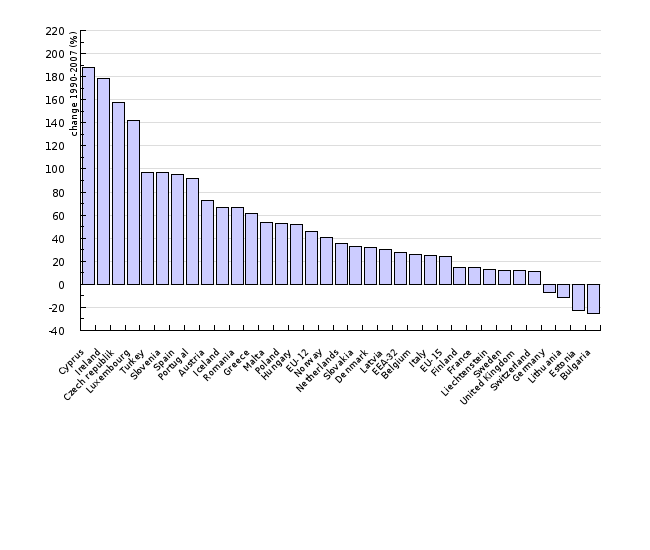[PR09] Transport emissions of greenhouse gases

Key message

Greenhouse gas emissions from transport in Slovenia increased up to 2007 by 165 % in comparison with 1986 (from road transport by 174 %). In this way, they strongly exceed the growth in the area of older members (EU-15), where greenhouse gas emissions from transport increased by 24 % in the period 1990–2007. The largest source of the majority of greenhouse gases is road transport, contributing 99.2 % of all emissions. The permanent growth of GHG from transport and their high share (26 % in 2007) in total emissions make difficult the endeavours of Slovenia to achieve the Kyoto Protocol commitments.
Definition
The indicator shows the greenhouse gas (GHG) emissions from transport in the past. The total emissions are subdivided into road, air, rail and maritime transport. Emissions from international bunkers are not included.
The Kyoto Protocol considers six pollutants from the GHG group; namely carbon dioxide (CO2), methane (CH4), dinitrous oxide (N2O), hydrofluorocarbons (HFC), perfluorocarbons (PFC) and sulphur hexafluoride (SF6). Due to comparability, the GHG amounts are calculated to a CO2 equivalent that considers the differences between the global warming potential of individual gases.
Charts
Environmental Agency of the Republic of Slovenia, 2009.
| 1986 | 1987 | 1988 | 1989 | 1990 | 1991 | 1992 | 1993 | 1994 | 1995 | ||
|---|---|---|---|---|---|---|---|---|---|---|---|
| road transport | 1000 t CO2 equivalents | 1955.7 | 2247.4 | 2429.3 | 2459.4 | 2668.4 | 2508.6 | 2618 | 3047.3 | 3373.2 | 3719.8 |
| rail transport | 1000 t CO2 equivalents | 76.9 | 76.3 | 73.7 | 74.9 | 72.7 | 81.2 | 54.6 | 46.2 | 46.7 | 48.8 |
| air transport | 1000 t CO2 equivalents | 0.6 | 0.4 | 0.6 | 0.9 | 1.1 | 0.6 | 1 | 1.8 | 2.1 | 2 |
| total | 1000 t CO2 equivalents | 2033 | 2324 | 2504 | 2535 | 2742 | 2590 | 2674 | 3095 | 3422 | 3771 |
| 1996 | 1997 | 1998 | 1999 | 2000 | 2001 | 2002 | 2003 | 2004 | 2005 | ||
| road transport | 1000 t CO2 equivalents | 4329.2 | 4406.5 | 3808.9 | 3630.5 | 3786.9 | 3929.6 | 3941.9 | 4090.6 | 4241.6 | 4525.2 |
| rail transport | 1000 t CO2 equivalents | 45.3 | 43.9 | 42.9 | 41.9 | 42.6 | 41.6 | 43.8 | 41.1 | 41.7 | 42.4 |
| air transport | 1000 t CO2 equivalents | 2.3 | 2.4 | 3 | 2.9 | 2.9 | 2.4 | 2.4 | 2.4 | 1.9 | 1.7 |
| total | 1000 t CO2 equivalents | 4377 | 4453 | 3855 | 3675 | 3832 | 3974 | 3988 | 4134 | 4285 | 4569 |
| 2006 | 2007 | ||||||||||
| road transport | 1000 t CO2 equivalents | 4753.2 | 5351.2 | ||||||||
| rail transport | 1000 t CO2 equivalents | 42.3 | 42.3 | ||||||||
| air transport | 1000 t CO2 equivalents | 1.5 | 1.7 | ||||||||
| total | 1000 t CO2 equivalents | 4797 | 5395 |
Environmental Agency of the Republic of Slovenia, 2009.
| CO2 | CH4 | N2O | - | road transport | rail transport | air transport | ||
|---|---|---|---|---|---|---|---|---|
| change 1986-2007 | % | 161.7 | -0.8 | 485.7 | 173.6 | -45 | 175 |
TERM02 Change in total GHG emissions from transport, European Environment Agency, 2009.
| Cyprus | Ireland | Czech republik | Luxembourg | Turkey | Slovenia | Spain | Portugal | Austria | Iceland | ||
|---|---|---|---|---|---|---|---|---|---|---|---|
| change 1990-2007 | % | 188 | 178 | 158 | 142 | 97 | 97 | 95 | 92 | 73 | 67 |
| Romania | Greece | Malta | Poland | Hungary | EU-12 | Norway | Netherlands | Slovakia | Denmark | ||
| change 1990-2007 | % | 67 | 61 | 54 | 53 | 52 | 46 | 41 | 35 | 33 | 32 |
| Latvia | EEA-32 | Belgium | Italy | EU-15 | Finland | France | Liechtenstein | Sweden | United Kingdom | ||
| change 1990-2007 | % | 30 | 28 | 26 | 25 | 24 | 15 | 15 | 13 | 12 | 12 |
| Switzerland | Germany | Lithuania | Estonia | Bulgaria | |||||||
| change 1990-2007 | % | 11 | -7 | -11 | -23 | -25 |
Goals
- Slovenia does not have a direct objective for transport GHG emissions; indirectly it is stipulated within the framework of the Kyoto Protocol, under which Slovenia must in the period 2008-2012 achieve 8 % lower emissions in comparison with base emissions.
- The Operational Programme for Limiting Greenhouse Gas Emissions until 2012, adopted in 2009, stipulates in the period 2008-2012 transport GHG emissions in the amount of 6.165 kt CO2 eq.
- In the proposal of the climate-energy package, the European Commission indicated that Slovenia must reduce GHG emissions by 2020 by approximately 6 % with regard to emissions in 2005 by:
• reducing emissions from sectors that are included in the European Emission Trading Scheme by 21 %,
• allowing a maximum 4 % increase of emissions from sectors that are not included in the European Emission Trading Scheme with regard to emissions from these sectors in 2005.
Comment
Mitigation of climate change is the biggest environmental development challenge facing humanity. Scientific results show that there is a connection between GHG emissions (CO2, CH4, N2O and F-gases) and atmospheric temperature. Since the amount of anthropogenic greenhouse gases in the atmosphere is intensively increasing due to increasing emissions, primarily due to the energy consumption of fuels, there is a high probability of a temperature increase in the future. This would strongly influence life on Earth. Therefore, a campaign was commenced at the international level, the objective of which is to reduce GHG emissions to values that would have an »acceptable« impact on the environment. The Kyoto Protocol stipulates emissions for the period 2008–2012 with regard to emissions in the base year, which are for Slovenia defined as the sum of CO2, CH4 and N2O emissions in 1986 (the base year for developed countries is 1990) and F-gases in 1995. The limitation of GHG emissions in Slovenia obtained a legal framework and specific objectives with the adoption of the Act Ratifying the Kyoto Protocol to the United Nations Framework Convention on Climate Change (OG RS, no. 60/2002).
At the 12th conference meeting of the contracting parties in 2006, negotiations on new objectives for the period after 2012 began. The leading role was taken over by the European Union, which adopted an objective in 2007 to reduce GHG emissions in 2020 by 20 or 30 % with regard to the base year. A 20 % reduction in emissions is required if the international agreement on the reduction of GHG emissions will not be adopted and a 30 % reduction in case of adoption of the international agreement.
According to the data of the Environmental Agency of the Republic of Slovenia, the largest share of GHG is contributed by the energy sector (81 % in 2007), of which energy supply contributes 34.1 %, followed by the transport sector (26.0 %). Transport GHG emissions in the period 1986-2007 more than doubled. Road transport emissions increased by 174 %, air transport emissions by 175 %; on the other hand, rail transport emissions reduced by 45 %. In the split of GHG in the considered period, N2O emissions increased the most (almost by five times) due to an increased share of vehicles with catalytic converters, which reduce cars’ exhaust emissions of certain air pollutants but produce N2O as a by-product. CO2 emissions increased by 162 %, CH4 emissions have been slightly reduced. In the total GHG emissions in 2007, transport represents 26 %.
Road transport is the source of the majority of emissions, since in 2007 it contributed 99.2 % of all emissions. The number of road motor vehicles as well as the power and capacity of their engines have been constantly increasing in Slovenia, while the specific use of new vehicles has not been reducing (MESP, 2009a). The development of infrastructure, especially in urban areas, cannot follow such growth; therefore, congestions are becoming more frequent. In recent years, the increase in road freight transport, especially transit transport through Slovenia, is also a major problem. The share of transit freight transport emissions in 2007 was estimated to be 12 % (MESP, 2009). Otherwise, freight transport causes 37 % of GHG emissions, while other emissions are caused by passenger transport (personal transport 61 %, bus transport 2 %) (ARSO, 2009).
According to the data of the European Environment Agency, the emissions of GHGs from transport (excluding international air and maritime transport) in the EU-15 area increased in the period 1990-2007 by 24 % and in the new Member States (EU-12) by 46 %. According to the growth of emissions, Slovenia is positioned in sixth place of 32 countries, which are members of the European Environment Agency. In the older Member States, the growth in emissions has stabilised in recent years, while in the same period the growth was significant in the new Member States. Road and air transport contributed to this growth; also GHG emissions from international aviation and navigation are increasing rapidly, but these emissions are not included in the GHG emission totals relevant for the Kyoto targets (EEA, 2009).
For the fulfilment of the Kyoto Protocol Commitment, the Government of the Republic of Slovenia adopted in 2003 (with amendments in 2004) the Operational Programme for Limiting Greenhouse Gas Emissions. In 2006, a new programme was adopted, supplemented and amended in 2009. In the last version, the Ministry established, similarly as is the case in the programme from 2006, that the emissions of GHGs from transport in Slovenia are on a critical path, while their control is of key importance for the fulfilment of Kyoto commitments. Especially worrying is the transit of heavy trucks through Slovenia, which has strongly increased since the integration of Slovenia into the EU. The measures to reduce transport emissions are the following: the reduction of emissions from passenger cars, promotion of public transport, sustainable freight transport and the replacement of fossil fuels with biofuels. Since the implementation of measures of previous operational programmes was insufficient, Slovenia will not be able to achieve the Kyoto objective only by domestic measures; therefore, the Operational programme stipulates the use of the Kyoto flexible mechanisms. This consequently means a need to provide funds from additional taxation of engine fuels (MESP, 2009).
Forecasts of the developments of GHGs from transport in the last Operational Programme for Limiting Greenhouse Gas Emissions were, in accordance with the past trends, corrected. Their volume will increase in 2008; in 2010, it is expected to decrease due to the economic crisis. Average emissions in the period 2008–2012 were estimated to be 6.165 kt CO2 eq., which is 14 % more than in 2007 (MESP, 2009).
The efficiency and adequacy of the measures of the operational programme are uncertain, especially since the state is not implementing an integrated transport policy, which would harmonise the transport system and enable a more equal development of sustainable transport modes. Since there is no efficient transport policy, the planned measures with regard to public transport and an increased share of railways for the transport of cargo and passengers are at issue (MESP, 2009a).
Methodology
Data for Slovenia and other countries:
Objectives summarised by: Resolution on National Environmental Action Plan 2005–2012, OG RS, no. 2/2006 , Operational Programme for Limiting Greenhouse Gas Emissions until 2012 (OP TGP-01) and the proposal of the climate-energy package of regulations.
Source database or source: For the calculation of the indicator, the official data on emissions of greenhouse gases was used, located at the Central Data Repository (CDR), summarised from the National Emissions Inventory.
Data administrator: Environmental Agency of the Republic of Slovenia (ARSO), Environment Office, Air Quality Division – contact person: Tajda Mekinda-Majaron.
Date of acquisition for this indicator: 15 April 2009.
Methodology and frequency of data collection for the indicator: The data is prepared annually on the basis of statistical data on fuel consumption, the calorific values of fuels and emission factors. The recommended methodology was prepared by the Intergovernmental Panel on Climate Change (IPCC). For the preparation of new records, data for the past is also frequently corrected.
Data processing methodology: The total GHG emissions were calculated as the weighted sum of emissions of individual substances. Weightings (Global warming potential = GWP) were stipulated in the instructions of the UN Framework Convention on Climate Change on the basis of the IPCC results, and amount to CO2 = 1, CH4 = 21, N2O = 310. The unit is a kt equivalent of CO2 emissions (CO2 eq). The average annual growths of emissions were calculated as [(last year/base year)(1 /number of years) –1] x 100.
Geographical coverage: The EEA-32 includes the group of 32 EEA Member States. That group is composed of the EU-15 (Belgium, Denmark, Germany, Greece, Spain, France, Ireland, Italy, Luxembourg, the Netherlands, Austria, Portugal, Finland, Sweden and the United Kingdom) and 12 new Member States EU-12 (Bulgaria, Cyprus, Czech Republic, Estonia, Latvia, Lithuania, Hungary, Malta, Poland, Romania, Slovakia, Slovenia).
Information concerning data quality:
- Advantages and disadvantages (at data level): The officially reported data, calculated on the basis of internationally verified methodologies, was used for the calculation of the indicator. Data and procedures are subject to an international review by the UNFCCC.
- Relevance, accuracy, robustness, uncertainty (at data level):
Reliability of the indicator (archive data): The reliability of the data was assessed for 1986, 2002 and 2003. For absolute data, it amounts to 16 %, 13,1 % and 12 %, and for trends for years 2002 and 2003 to 4 % or 3 % respectively. The reliability of emission factors and data on activities was assessed on the basis of an expert assessment.
Uncertainty of the indicator (scenarios/projections): Projections have not been prepared.
- Overall assessment (1 = no major comments, 3 = data to be considered with reservation):
Relevance: 1
Accuracy: 2
Completeness over time: 1
Completeness over space: 1
Other sources and literature:
- ARSO, 2009. Slovenia’s National Inventory Report 2009. 2009. Ljubljana, Environmental Agency of the Republic of Slovenia.
- EEA, 2009. TERM02 Change in total GHG emissions from transport. Assessment August 2009, European Environment Agency.
- MESP, 2009: Operational Programme for Limiting Greenhouse Gas Emissions until 2012 (OP TGP-01). 2009. Ljubljana, Ministry of the Environment and Spatial Planning.
- MESP, 2009a: Second report on the Implementation of the Operational Programme for Limiting Greenhouse Gas Emissions until 2012 for 2008. 2009. Ljubljana, Ministry of the Environment and Spatial Planning.
- Communication from the Commission to the European Council and the European Parliament - An Energy Policy for Europe {SEC(2007) 12}. 2007. Brussels, Commission of the European Communities.
- Act Ratifying the Kyoto Protocol to the United Nations Framework Convention on Climate Change (MKPOKSP). OG RS, no. 60/2002.











